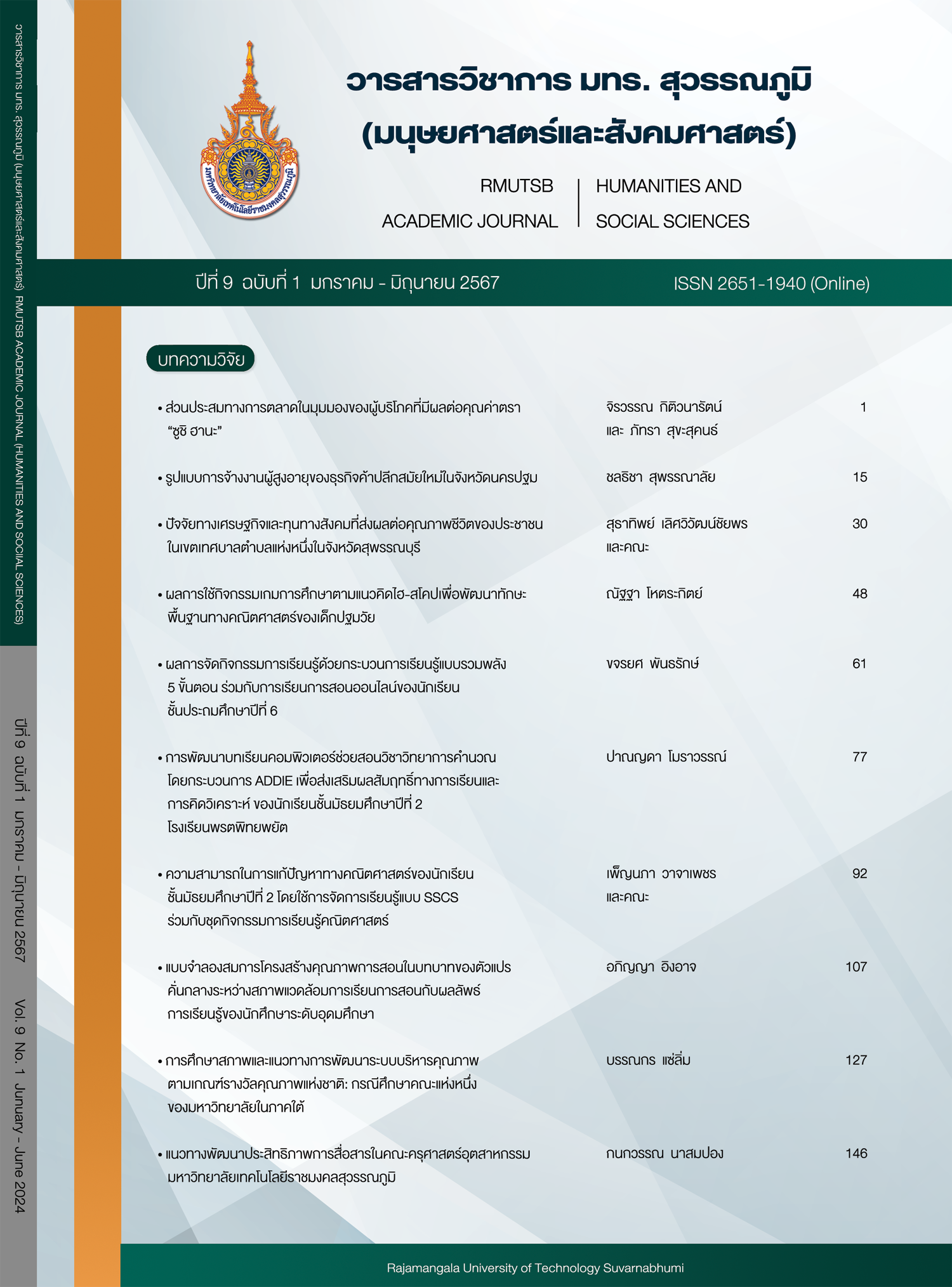Marketing mix in consumer's perspective affecting Sushi Hana's brand equity
Main Article Content
Abstract
The objectives of this research were to 1) study the importance level of the marketing mix from the consumer's perspective of "Sushi Hana", 2) study Sushi Hana’s brand equity from the consumer's perspective, and 3) study the marketing mix in the consumer's perspective that affected Sushi Hana's brand equity. The sample group used in this study, obtained through systematic random sampling technique, included 400 consumers who had used Sushi Hana's services. Data was collected through a questionnaire as a research instrument. The reliability of marketing mix from the consumer's perspective was 0.956 and Sushi Hana’s brand equity was 0.936. The statistics used for data analysis were frequency, mean, percentage, and standard deviation, as well as multiple regression analysis using the stepwise method.
The research findings showed that 1) the marketing mix from the consumer's perspective of "Sushi Hana" had an overall significance at a high level, 2) the Sushi Hana’s brand equity from the consumer's perspective had an overall significance at a high level, and 3) marketing mix in consumer's perspective from 7 aspects found that only 5 aspects had a statistically significant positive effect on the "Sushi Hana" brand equity at 0.01 level. The most effective aspect was completion cost to the customer, communication, customer value, and comfort, respectively. The marketing mix in these 5 aspects could explain the variation in the value of the “Sushi Hana” brand equity at 67.80%. Therefore, if entrepreneurs paid attention to these 5 marketing mixes, the brand equity of the “Sushi Hana” could be enhanced significantly.
Article Details

This work is licensed under a Creative Commons Attribution-NonCommercial-NoDerivatives 4.0 International License.
References
Aaker, D. A. (1998). Building strong brands. New York: Free Press.
Boontang, A., & Visetprapa, P. (2021). Factors affecting perceived brand equity Momo Paradise for consumers in Bangkok. Retrieved 27 April 2023, from https://mmm.ru.ac.th/MMM/IS/twin-9/6214154044.pdf (in Thai)
Cochran, W. G. (1977). Sampling techniques. New York: John Wiley & Sons.
Cronbach, L. J. (1974). Essential of psychological testing. New York: HanperCollins.
GSB Research. (2019). The restaurant business. Retrieved 16 October 2022, from https://www.gsbresearch.or.th/wp-content/uploads/2019/10/IN_restaurant_10_62_detail.pdf (in Thai)
Hemphaiboon, J. (2019). The decision making of going to eat at “Yok Yor Rim Krong” (Master’s thesis). Siam University, Bangkok. (in Thai)
Jetro Bangkok. (2021). Survey of Japanese restaurants. Retrieved 16 October 2022, from https://www.jetro.go.jp/ext_images/thailand/food/JapaneseRestaurantsSurveyTH2021.pdf (in Thai)
Kennedy, I. (2022). Sample size determination in test-retest and Cronbach alpha reliability estimates. British Journal of Contemporary Education, 2(1), 17-29.
Kamnuanthong, S. (2019). Service quality and the trustworthiness affecting the customer’s loyalty in using the service of Chom-in farm in Danchang District, Suphanburi. RMUTSB Academic Journal (Humanities and Social Sciences), 4(2), 173-185. (in Thai)
Kitivanarat, C., Wisedsind, N., & Sukasukont, P. (2022). The adaptation of food business after the COVID-19 crisis. Journal of Management Science Review, 24(2), 137-146. (in Thai)
Koichi, S. (1989). Advertising theory and strategies. Tokyo: Souseisha Book.
Kuljaroen, P. (2020). Factors influencing consumer satisfaction with Yayoi Seacon Bangkok branch (Master’s thesis). Siam University, Bangkok. (in Thai)
Lauterborn, B. (1990). New marketing litany; Four P’s passe; C-words take over. Advertising Age, 61(41), 26.
Likert, R. A. (1932). Technique for the measurement of attitude. Archives Psychological, 3(1), 42-48.
Nunnally, J. C., & Bernstein, I. H. (1994). Psychometric theory. New York: McGraw-Hill.
Panich, T. (2022). Marketing factors affecting Japanese restaurant’s decision making in Soi Sukhumvit 55 in Bangkok metropolitan area. Rajapark Journal, 16(45), 281-296. (in Thai)
Phusee-Orn, S. (2008). Statistics package for the social sciences (2nd ed.). Kalasin: Prasan Printing. (in Thai)
Prasith-rathsint, P. (2005). Applications of statistical methods in research (5th ed.). Bangkok: Samladda. (in Thai)
Saeng-on, A. (2016). The effectiveness of marketing strategies on consumer’s behavior toward wine consumption in wine bar and restaurant in Bangkok. RMUTSB Academic Journal (Humanities and Social Sciences), 1(1), 1-13. (in Thai)
Sanglimsuwan, S., & Songwathana, K. (2021). Causal factors influencing customer’s decision of visiting Thai cuisine restaurants. Journal of BU Academic Review, 20(2), 158-172. (in Thai)
Sushi Hana (Thailand) Company Limited. (2021). Exploring Sushi Hana image impression & brand experience report. Samut Prakan: Sushi Hana (Thailand) Company Limited. (Unpublished manuscript). (in Thai)
Thanasuwichagon, P., Visitnitkija, C., & Tanphan, I. (2020). Service quality of Krua Mai Nam restaurant. Narkbhutparitat Journal, 12(1), 86-96. (in Thai)


